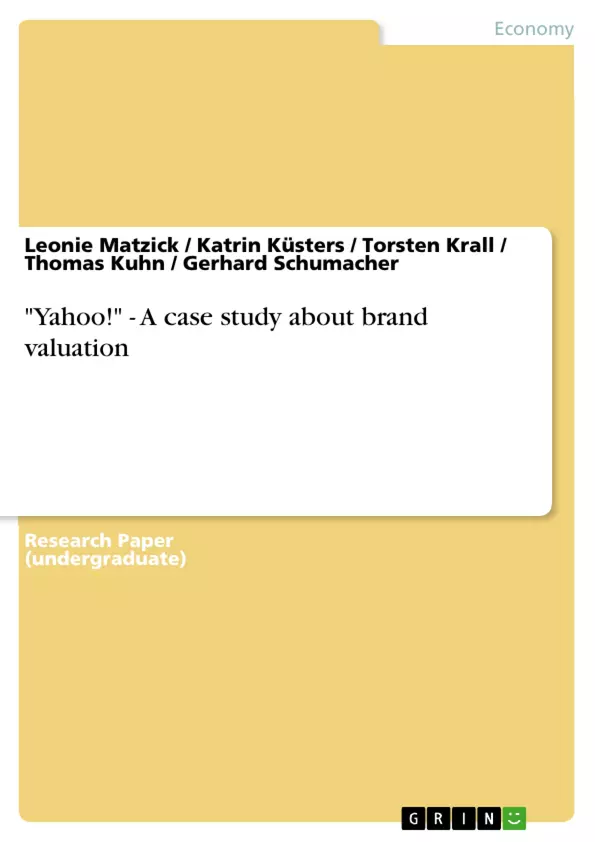First of all, the following chapter will deal with the framework of brand evaluation. To give an idea of the internet service provider Yahoo!, the company will be introduced in the first part.
The next part concentrates on the role an established brand plays and what effect it has.
The following chapter will point out what it means to lead a brand and which value it has to a company. As a matter of course, the conclusions will be related to the special case of Yahoo!.
To provide a general survey of the topic of brand evaluation, the next chapter deals with the economical and judicial frame. It explains the situation within the topic of intangible assets and their special treatment concerning the balance sheet. In Chapter 2.4.2 the different causes for brand evaluation will be described and the cause of acquisition will be determined as the appropriate cause for the present case of Yahoo!. Chapter 2.5 concentrates on the necessary requirements for a sufficient and objective brand evaluation, especially in the case of acquisition.
Before three of the most important and established methods of brand evaluation will be analysed, the large number of all current methods have to be categorised. For that reason the third chapter will start with the classification of methods. After regarding the three possible categories, the last part will come to the decision for just one category, which comes into question for the present case.(...)
After these three analyses, it is possible to overlook the whole topic of brand evaluation. Chapter 2.5 defines the general requirements for an objective method of brand evaluation. The following chapters will survey three of the most popular models and will point out their advantages and disadvantages. In the result conclusions can be drawn from the accomplished analyses. In this way a new suitable method of calculation will be developed in Chapter 4.2. It is a try to find a solution for the problem of the current methods’ weaknesses and to create an objective method, which regards the most important criteria and fulfils the requirements for an impartial evaluation.
Inhaltsverzeichnis (Table of Contents)
- Introduction
- 1. Definition
- 1.1 Brand
- 1.1.1 Brand Equity
- 1.2 Problem Definition
- 1.3 Course of Work
- 2. Framework of Brand Evaluation
- 2.1 The Internet Service Provider Yahoo!
- 2.1.1 The Company
- 2.1.2 The Funding
- 2.2 Brand Functions
- 2.2.1 Producer's View
- 2.2.2 Sales Representative's View
- 2.2.3 Consumer's View
- 2.2.4 Yahoo!'s View
- 2.3 Meaning of Branding
- 2.4 Situation Analysis
- 2.4.1 Economic Framework
- 2.4.2 Acquisition as Relevant Cause for Brand Evaluation
- 2.4.3 A Brand's Value in the existing Accounting Standards
- 2.5 Method Requirements for the Cause of Acquisition
- 3. Methods of Brand Evaluation
- 3.1 Classification and Choice of Methods
- 3.1.1 The Different Approaches
- 3.1.2 Finance Orientated Methods
- 3.1.3 Behavioural Science Orientated Methods
- 3.1.4 Integrative Methods
- 3.1.5 The Choice
- 4. Methods of Brand Evaluation
- 4.1 Presentation of the Selected Methods Regarding the Case of Acquisition
- 4.1.1 Brand Rating
- 4.1.1.1 Method Presentation
- 4.1.1.2 Critical Assessment
- 4.1.2 Millward Brown
- 4.1.2.1 Method Presentation
- 4.1.2.2 Critical Assessment
- 4.1.3 Interbrand
- 4.1.3.1 Method Presentation
- 4.1.3.2 Critical Assessment
- 4.2 Development of a new reliable Method
- 4.2.1 Framework
- 4.2.2 Application
- 5. Conclusion
- 5.1 New Method as Objective Solution
- 5.2 Outlook: A Standardised Method
Zielsetzung und Themenschwerpunkte (Objectives and Key Themes)
This case study examines the brand valuation of Yahoo!, specifically within the context of an acquisition scenario. The study aims to explore different brand valuation methods, critically assess their applicability to the Yahoo! case, and ultimately propose a new, more reliable method for brand valuation. Key themes addressed include:- The definition and importance of brand equity in the context of corporate acquisitions
- The various approaches to brand valuation, encompassing finance-oriented, behavioral science-oriented, and integrative methods
- A critical analysis of established brand valuation methodologies, including Brand Rating, Millward Brown, and Interbrand
- The development and implementation of a novel brand valuation method designed to address the limitations of existing approaches
- The potential for a standardized brand valuation methodology to facilitate more objective and reliable assessments of brand value.
Zusammenfassung der Kapitel (Chapter Summaries)
The introductory chapter defines "brand" and "brand equity" and outlines the study's objectives, focusing on the challenges of valuing Yahoo!'s brand in an acquisition scenario. Chapter 2 delves into the framework of brand evaluation, presenting Yahoo! as the case study. It explores the company's background, funding structure, and its brand's various functions from the perspectives of producers, sales representatives, consumers, and Yahoo! itself. Chapter 3 provides a comprehensive classification and analysis of brand valuation methods, categorized into finance-oriented, behavioral science-oriented, and integrative approaches. It discusses the limitations of existing methods and identifies the need for a more robust approach. Chapter 4 focuses on presenting and critically assessing specific methods of brand valuation, including Brand Rating, Millward Brown, and Interbrand. The chapter then outlines the development of a new method, detailing its framework and application. Chapter 5 concludes the study, presenting the new method as a solution to the challenges of brand valuation in acquisition scenarios. It highlights the potential for a standardized brand valuation methodology, offering a more objective and reliable approach.Schlüsselwörter (Keywords)
The study focuses on the valuation of intangible assets, specifically brand equity, in the context of corporate acquisitions. The work examines various methodologies including financial, behavioral, and integrative approaches, with a particular emphasis on critical analysis of methods like Brand Rating, Millward Brown, and Interbrand. The study culminates in the development of a new reliable method for brand valuation, addressing the limitations of existing approaches.- Quote paper
- Bachelor of Business Administration Leonie Matzick (Author), Katrin Küsters (Author), Torsten Krall (Author), Thomas Kuhn (Author), Gerhard Schumacher (Author), 2008, "Yahoo!" - A case study about brand valuation, Munich, GRIN Verlag, https://www.grin.com/document/115082



